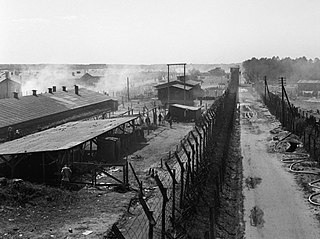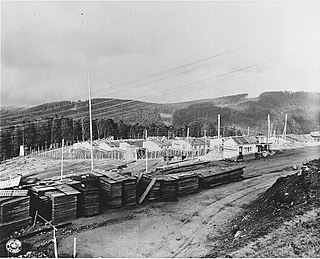Related Research Articles

Dame Vanessa Redgrave is an English actress. Throughout her career spanning over six decades, Redgrave has garnered numerous accolades, including an Academy Award, a Tony Award and two Primetime Emmy Awards, making her one of the few performers to achieve the Triple Crown of Acting. She has also received various honorary awards, including the BAFTA Fellowship Award, the Golden Lion Honorary Award, and an induction into the American Theatre Hall of Fame.

Bergen-Belsen, or Belsen, was a Nazi concentration camp in what is today Lower Saxony in northern Germany, southwest of the town of Bergen near Celle. Originally established as a prisoner of war camp, in 1943, parts of it became a concentration camp. Initially this was an "exchange camp", where Jewish hostages were held with the intention of exchanging them for German prisoners of war held overseas. The camp was later expanded to hold Jews from other concentration camps.

Natzweiler-Struthof was a Nazi concentration camp located in the Vosges Mountains close to the villages of Natzweiler and Struthof in the Gau Baden-Alsace of Germany, on territory annexed from France on a de facto basis in 1940. It operated from 21 May 1941 to September 1944, and was the only concentration camp established by the Germans in the territory of pre-war France. The camp was located in a heavily-forested and isolated area at an elevation of 800 metres (2,600 ft).

Neuengamme was a network of Nazi concentration camps in Northern Germany that consisted of the main camp, Neuengamme, and more than 85 satellite camps. Established in 1938 near the village of Neuengamme in the Bergedorf district of Hamburg, the Neuengamme camp became the largest concentration camp in Northwest Germany. Over 100,000 prisoners came through Neuengamme and its subcamps, 24 of which were for women. The verified death toll is 42,900: 14,000 in the main camp, 12,800 in the subcamps, and 16,100 in the death marches and bombings during the final weeks of World War II. Following Germany's defeat in 1945, the British Army used the site as an internment camp for SS and other Nazi officials. In 1948, the British transferred the land to the Free Hanseatic City of Hamburg, which summarily demolished the camp's wooden barracks and built in its stead a prison cell block, converting the former concentration camp site into two state prisons operated by the Hamburg authorities from 1950 to 2004. Following protests by various groups of survivors and allies, the site now serves as a memorial. It is situated 15 km southeast of the centre of Hamburg.

The Belsen trials were a series of several trials that the Allied occupation forces conducted against former officials and functionaries of Nazi Germany after the end of World War II. British Army and civilian personnel ran the trials and staffed the prosecution and judges.

Herta Bothe was a German concentration camp guard during World War II. She was imprisoned for war crimes after the defeat of Nazi Germany, and was subsequently released early from prison on 22 December 1951.

Glynneath, also spelt Glyn-neath and Glyn Neath, is a small town, community and electoral ward lying on the River Neath in the county borough of Neath Port Talbot, Wales. It was formerly in the historic county of Glamorgan. Glynneath ward covers only part of the community, with some 840 electors included in the neighbouring ward of Blaengwrach.

The Kastner train is the name usually given to a rescue operation which saved the lives of over 1,600 Jews from Hungary during World War 2. It consisted of 35 cattle wagons that left Budapest on 30 June 1944, during the German occupation of Hungary, ultimately arriving safely in Switzerland after a large ransom was paid to the Nazis. The train was named after Rudolf Kastner, a Hungarian-Jewish lawyer and journalist, who was a founding member of the Budapest Aid and Rescue Committee, a group that smuggled Jews out of occupied Europe during the Holocaust. Kastner negotiated with Adolf Eichmann, the German SS officer in charge of deporting Hungary's Jews to Auschwitz in German-occupied Poland, to allow over 1,600 Jews to escape in exchange for gold, diamonds, and cash. The deal was controversial and has been the subject of much debate and criticism, with some accusing Kastner of collaborating with the Nazis, while others argue that he made difficult choices to save lives.

Bergen-Belsen displaced persons camp was a displaced persons (DP) camp for refugees after World War II, in Lower Saxony in northwestern Germany, southwest of the town of Bergen near Celle. It was in operation from the summer of 1945 until September 1950. For a time, Belsen DP camp was the largest Jewish DP camp in Germany and the only one in the British occupation zone with an exclusively Jewish population. The camp was under British authority and overseen by the United Nations Relief and Rehabilitation Administration (UNRRA) with camp directors that included Simon Bloomberg. Today, the camp is a Bundeswehr barracks, having been a British Army base until 2015.

Tobias Simpson Menzies is an English stage, television and film actor. He is known for playing Prince Philip, Duke of Edinburgh in the third and fourth seasons of Netflix's series The Crown, for which he won the Primetime Emmy Award for Outstanding Supporting Actor in a Drama Series and received Golden Globe and British Academy Television Award nominations. Menzies also played Frank and Jonathan "Black Jack" Randall in Starz's Outlander, for which he received a Golden Globe Award nomination, in addition to his roles as Brutus in HBO's Rome and Edmure Tully in HBO's Game of Thrones.

Caesar and Cleopatra is a play written in 1898 by George Bernard Shaw that depicts a fictionalized account of the relationship between Julius Caesar and Cleopatra. It was first published with Captain Brassbound's Conversion and The Devil's Disciple in Shaw's 1901 collection Three Plays for Puritans. It was first performed in a single staged reading at Newcastle upon Tyne on 15 March 1899, to secure the copyright. The play was produced in New York in 1906 and in London at the Savoy Theatre in 1907.
Helen Rae Bamber OBE, néeHelen Balmuth, was a British psychotherapist and human rights activist. She worked with Holocaust survivors in Germany after the concentration camps were liberated in 1945. In 1947, she returned to Britain and continued her work, helping to establish Amnesty International and later co-founding the Medical Foundation for the Care of Victims of Torture. In 2005, she created the Helen Bamber Foundation to help survivors of human rights violations.

Reverend Leslie Henry Hardman MBE HCF was an Orthodox Rabbi and the first Jewish British Army chaplain to enter Bergen-Belsen concentration camp, an experience "that made him a public figure, both within his community and outside it".

Brigadier Hugh Llewellyn Glyn Hughes, was a British military officer in the Royal Army Medical Corps and later a medical administrator, educationalist and sports administrator. Hughes served in both the First and Second World Wars and is notable for his role in the care and rehabilitation of the victims of Bergen-Belsen concentration camp.
Arnold Peter Meiklejohn was an English physician and academic, specializing in nutrition.
Alexander Paton was a British gastroenterologist, writer and postgraduate dean for North-West London hospitals, who was a specialist in alcohol misuse.

In early April 1945, at the request of the British Army, the British Red Cross and the War Office called for 100 volunteer medical students from nine London teaching hospitals to assist in feeding starving Dutch children who had been liberated from German occupation by advancing Allied forces. However, in the meantime, British troops had liberated Bergen-Belsen concentration camp and the students were diverted there on the day they were due to travel to the Netherlands. The students had previously spent most of the Second World War at school and in medical training.

Michael John Hargrave was a British general practitioner in Wootton Bassett, Wiltshire, who in 1945 assisted British Army occupation forces at the recently-liberated Bergen-Belsen concentration camp when he volunteered as a medical student from Westminster Hospital at the age of 21.

Bergen-Belsen 1945: A Medical Student's Journal is Michael Hargrave's diary of his experiences providing medical assistance to the former inmates of Bergen-Belsen concentration camp between 28 April and 28 May 1945. It was written for his mother after he volunteered for the work while he was a student at Westminster Hospital Medical School in London. It is a typescript of the diary, which was originally hand-written, and begins with a foreword by the head of research at the Imperial War Museum and brief background notes by Hargrave's son David. Centre pages include photographs of the London medical students and the state of the camp, including the "human laundry".
References
- ↑ Transcript of Johnson's recollections of his experiences entitled "The Relief of Belsen concentration camp: recollections and reflections of a British Army doctor", 1970, ca., accessed at the United States Holocaust Museum, 6 April 2013.